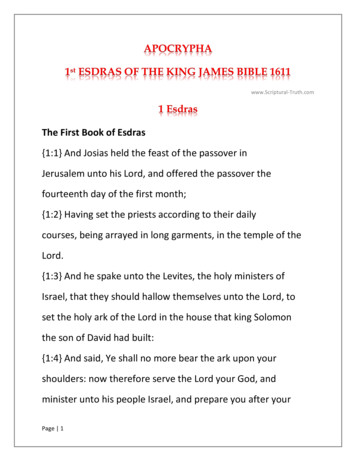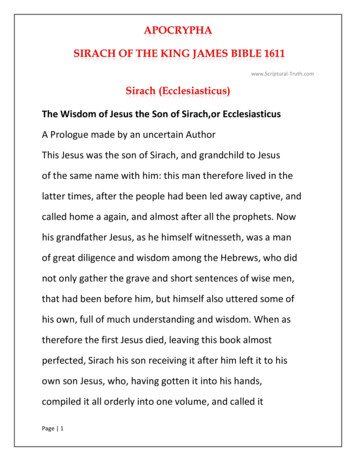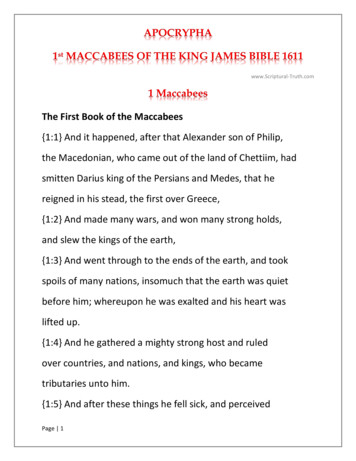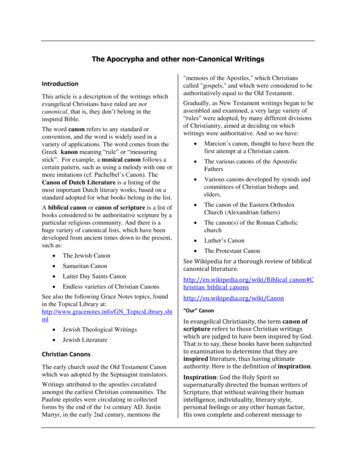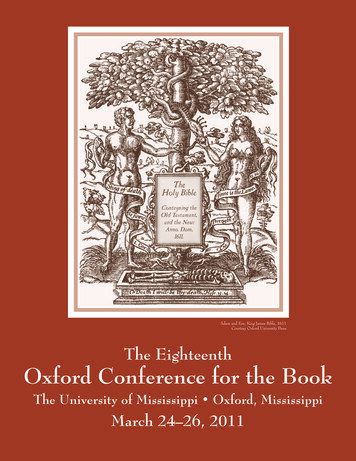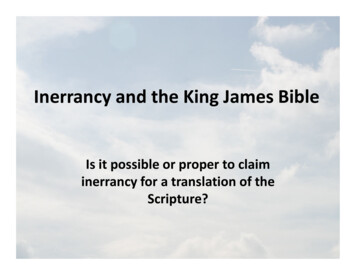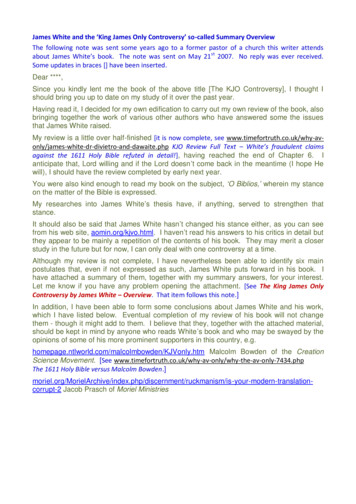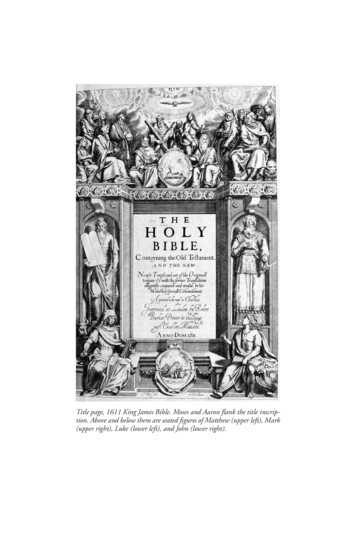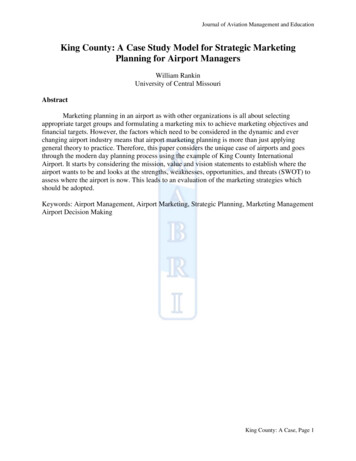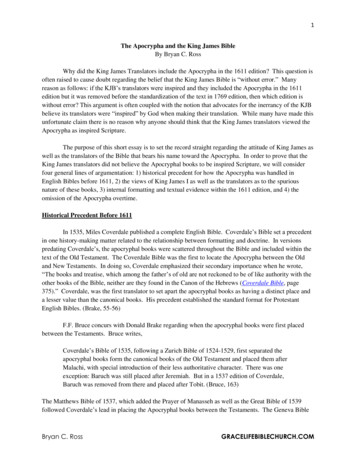
Transcription
1The Apocrypha and the King James BibleBy Bryan C. RossWhy did the King James Translators include the Apocrypha in the 1611 edition? This question isoften raised to cause doubt regarding the belief that the King James Bible is “without error.” Manyreason as follows: if the KJB’s translators were inspired and they included the Apocrypha in the 1611edition but it was removed before the standardization of the text in 1769 edition, then which edition iswithout error? This argument is often coupled with the notion that advocates for the inerrancy of the KJBbelieve its translators were “inspired” by God when making their translation. While many have made thisunfortunate claim there is no reason why anyone should think that the King James translators viewed theApocrypha as inspired Scripture.The purpose of this short essay is to set the record straight regarding the attitude of King James aswell as the translators of the Bible that bears his name toward the Apocrypha. In order to prove that theKing James translators did not believe the Apocryphal books to be inspired Scripture, we will considerfour general lines of argumentation: 1) historical precedent for how the Apocrypha was handled inEnglish Bibles before 1611, 2) the views of King James I as well as the translators as to the spuriousnature of these books, 3) internal formatting and textual evidence within the 1611 edition, and 4) theomission of the Apocrypha overtime.Historical Precedent Before 1611In 1535, Miles Coverdale published a complete English Bible. Coverdale’s Bible set a precedentin one history-making matter related to the relationship between formatting and doctrine. In versionspredating Coverdale’s, the apocryphal books were scattered throughout the Bible and included within thetext of the Old Testament. The Coverdale Bible was the first to locate the Apocrypha between the Oldand New Testaments. In doing so, Coverdale emphasized their secondary importance when he wrote,“The books and treatise, which among the father’s of old are not reckoned to be of like authority with theother books of the Bible, neither are they found in the Canon of the Hebrews (Coverdale Bible, page375).” Coverdale, was the first translator to set apart the apocryphal books as having a distinct place anda lesser value than the canonical books. His precedent established the standard format for ProtestantEnglish Bibles. (Brake, 55-56)F.F. Bruce concurs with Donald Brake regarding when the apocryphal books were first placedbetween the Testaments. Bruce writes,Coverdale’s Bible of 1535, following a Zurich Bible of 1524-1529, first separated theapocryphal books form the canonical books of the Old Testament and placed them afterMalachi, with special introduction of their less authoritative character. There was oneexception: Baruch was still placed after Jeremiah. But in a 1537 edition of Coverdale,Baruch was removed from there and placed after Tobit. (Bruce, 163)The Matthews Bible of 1537, which added the Prayer of Manasseh as well as the Great Bible of 1539followed Coverdale’s lead in placing the Apocryphal books between the Testaments. The Geneva BibleBryan C. RossGRACELIFEBIBLECHURCH.COM
2of 1560 prefaced the Apocryphal section (between the Testaments) with the strongest statement to dateagainst the canonicity of the Apocryphal books (Geneva Bible, 775). Moreover, the Geneva translatorsprinted the Prayer of Manasseh as an appendix to 2 Chronicles, adding a notation as to its apocryphalcharacter. The Bishops Bible of 1568 also separated these books from the rest of the Old Testament andincluded a separate title-page; however, they included no apologetic reason for doing so. This omissionangered the Puritan party within the Church of England, which agreed with the Genevan tradition and wasagainst the canonicity of the Apocrypha. The first English Bibles to omit the Apocrypha were somecopies of the Geneva version published at Geneva in 1599. There is a gap in the page-numberingbetween the Testaments, indicating that the decision to omit the Apocrypha was made after the pageswere printed and prior to binding. (Bruce, 163-164)Views of King James and the TranslatorsBy the early 17th Century when the translation work on the Authorized Version began, there wasalready historical precedent for including the Apocrypha in a separate section between the Testaments.Furthermore, Protestants had been using this device to put forth their belief that the Apocryphal bookswere not inspired Scripture since the Coverdale Bible of 1535. Consequently, the King James translatorswere merely following the standard Protestant practice of the day as to how to handle the Apocrypha inthe English Bible. These realities reflect the religious tension still present in the early 17th Century; theChurch of England retained the custom of reading from the Apocrypha in public worship services duringcertain seasons of the year (Hills, 98). In fact, King James himself did not view the Apocryphal books asScripture, as The Political Works of James I makes clear.“As for the Scriptures; no man doubteht I will beleeue them; But euenfor the Apocrypha;I hold them in the same accompt that the Ancient did: They are still printed and boundwith our Bibles, and publikely read in our Churches: I reuerence them as the writings ofholy and good men: but since they are not found in the Canon, wee accompt them to beesecunde lectionis, or ordinis and therefore not sufficient whereupon alone to gorund anyarticle of Faith, expect it be confirmed by some other place of Canonicall Scriptuere;”(123)“And it is a small corrupting of Scriptures to make all, or the most part of the Apocryphaof equall faith with the Canonicall Scriptures, contrary to the Fathers opinions andDecrees of ancient Councels?” (137)Despite the fact that most of the translators agreed with King James with respect to theApocrypha, it was included in the translation because of the influence of Archbishop Bancroft.Being an Anglican, Bancroft made the decision to include the Apocrypha in the 1611 despitestaunch Puritan opposition. (Brake, 147)According to Adam Nicolson, author of God’s Secretaries: The Making of the KingJames Bible, the Apocrypha is generally acknowledged to be the least satisfactory in terms oftranslation when compared with the rest of the King James Bible. (Nicholson, 199) “Becausethey were not considered inspired by God, the translation in these books is much freer than theBryan C. RossGRACELIFEBIBLECHURCH.COM
3translation of the canonical books. In fact, the translation principle that each original word musthave a direct English equivalent was abandoned on occasion.” (Brake, 147) The SecondCambridge Company assigned with the task of translating the Apocrypha under the leadership ofJohn Duport, gave the following reasons for not admitting the apocryphal books into the canon,or list of inspired Scriptures.1. “Not one of them is in the Hebrew langue, which was alone used by the inspiredhistorians and poets of the Old Testament.2. Not one of the writers lays any claim to inspiration.3. These books were never acknowledged as sacred Scriptures by the Jewish Church, andtherefore were never sanction by our Lord.4. They were not allowed a place among the sacred books, during the first four centuries ofthe Christian Church.5. They contain fabulous statements, and statements which contradict not only the canonicalScriptures but themselves; as when in the two Book of Maccabees, Antiochus Epiphaniesis made to die three different deaths in as many different places.6. It inculcates doctrines at variance with the bible, such a prayers for the dead, and sinlessperfection.7. It teaches immoral practices, such as lying, suicide, assassination and magicalincantation. For these and other reasons, the Apocryphal books, which are all in Greek,expect one which is extant only in Latin, are valuable as ancient documents, illustrativeof manners, language, opinions and history of the East.” (McClure, 185-186)If the translators felt so strongly against the Scriptural nature of the Apocryphal books, whydid they include them between the Testaments? The answer is that they were simply followinginstructions. Prior to the beginning the translation process Bishop Bancroft issued a list of fifteenrules that the various companies of translators were expected to follow when doing their work.The first rule states, “The ordinary Bible read in the Church, commonly called the Bishop’s Bible,to be followed, and as little altered as the Truth of the original will permit.” (Teems, 260) TheBishop’s Bible was to serve as the base text or starting point for the translation process. As notedabove, the Bishop’s Bible followed Coverdale’s precedent in offsetting the Apocryphal booksfrom the rest of the Old Testament by separating those books into their own section between theTestaments.Internal EvidenceLastly, an examination of a 1611 edition of the Authorized Version bears witness to ainteresting phenomenon that signifies the attitude of the translators toward the Apocryphal books.Every page of the Old and New Testament contains a brief summary in the top margin as to whatthe reader will find on each page. For example, in the top margin for I Chronicles 15 one reads,“The bringing of the Arke.” In contrast, when one considers the Apocryphal section of the 1611,beginning with I Esdras and ending with II Maccabees every page has Apocypha written twice inthe top margin. This practice is akin to stamping spurious or false on the top of every page.Moreover, at the end of Malachi the reader will observe the following statement, “The end of theBryan C. RossGRACELIFEBIBLECHURCH.COM
4Prophets.” Likewise, the end of II Maccabees contains the following quotation along the bottommargin, “The end of the Apocrypha.” Immediately adjacent the reader will observe an ornate titlepage indicating the beginning of the New Testament. In short, the translators made every literaryand visual effort to make it clear to their readership that they did not view the Apocryphal booksas inspired Scripture.Conclusion: The Omission of the Apocrypha Over TimeIn 1615, Archbishop Abbot , Brancroft’s successor forbade any printer from issuing aBible without the Apocrypha, on pain of one year’s imprisonment. (Bruce, 164) An edition of theGeneva Bible published at Amstermade in 1640 omitted the Apocrypha deliberately: it was notsimply the binder’s doing this time. A defense of the omission was inserted between theTestaments. “This omission was in line with the prevailing tendency in England at this time,where, in 1644, Parliament ordered that the canonical books only should be publically read inChurch. This tendency was reversed after the Restoration, but the exclusion of the Apocryphabecame increasingly popular among the Nonconformists. It is noteworthy that the first EnglishBible printed in America (1782-3) lacked the Apocrypha.” (Bruce, 164)The argument that the King James Version translators must have considered theApocrypha to be inspired since they included it in the 1611 edition is wrong. The Apocrypha wasincluded based upon the historical practice up to that time to include it. However, it is clear thatneither King James nor the translators considered the Apocrypha to be inspired, and in fact, thevery layout and design of the 1611 edition testifies to the face that the Apocrypha was notconsidered canonical. Subsequent to 1611, as the religious and political situation in Englandchanged so did the handling of the Apocrypha in the English Bible. By the time the text of theKing James Bible was standardized in 1769, it had long been resolved that the Apocrypha wouldnot be included in Protestant editions of the Bible, and thus, the Apocrypha went from beingincluded in a manner that testified to its lack of canonicity to being omitted in its entirety.Bryan C. RossGRACELIFEBIBLECHURCH.COM
5Works CitedBrake, Donald L. A Visual History of the King James Bible. Grand Rapids, MI: Baker Books,2011.Bruce, F.F. The Books and the Parchments: How We God Our English Bible. Old Tappan, NJ:Fleming H. Revell, 1950.Hills, Edward F. The King James Version Defended. Des Moines, IA: The Christian ResearchPress, 1954.James I, King. The Political Works of James I. Harvard University Press, 1616 (reprinted in1918).http://books.google.com/books?id eGoLAAAAYAAJ&printsec frontcover&source gbsge summary r&cad 0#v onepage&q&f falseMcClure, Alexander. The Translators Revived. Mobile: AL, R.E. Publications, 1858.Nicholson, Adam. God’s Secretaries: The Making of the King James Bible. New York, NY:Harper Collins Publishers, 2003.Teems, David. Majestie: The King Behind the King James Bible. Nashville, TN: Thomas Nelson,2010.Bible LinksCoverdale Bible (1535)Geneva Bible (1560)Bishops Bible (1568)King James 1611 ImagesTable of Contents PageLamentations (Old Testament)Tolbit (Apocrypha)II Corinthians 6 (New Testament)Bryan C. RossGRACELIFEBIBLECHURCH.COM
Geneva Bible published at Amstermade in 1640 omitted the Apocrypha deliberately: it was not simply the binder’s doing this time. A defense of the omission was inserted between the Testaments. “This omission was in line with the prevailing tendency in England at this time, where, in 1644, Parliament ordered that the canonical books only should be publically read in Church. This tendency was .
